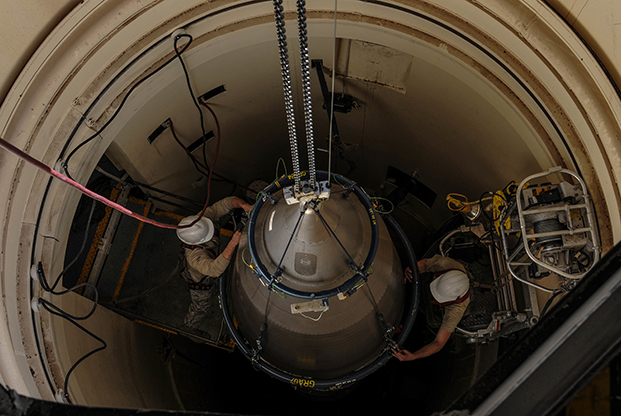
Airmen from the 90th Missile Maintenance Squadron prepare a reentry system for removal from a launch facility on Feb. 2, 2018, in the F. E. Warren AFB, Wyo., missile complex. Air Force photo by A1C Braydon Williams.
Modernizing America’s nuclear triad will cost the Defense and Energy Departments $494 billion through Fiscal 2028, according to a new 10-year outlook from the Congressional Budget Office.
That topline figure, which is 23 percent higher than CBO’s 2017 estimate, includes a $18 billion rise in the price of operating and modernizing the Air Force’s intercontinental ballistic missile enterprise, now expected to total $61 billion over 10 years, as well as a $6 billion rise in bomber fleet and Long-Range Standoff Weapon costs. Those are expected to total $49 billion in the next decade.
“CBO projects that $432 billion of that total would be needed to implement the administration’s 2019 plans as DOD and DOE have laid them out—provided those plans did not change or experience any cost growth or schedule delays,” according to the Jan. 24 report. “The remaining $62 billion of the 10-year total represents CBO’s estimate of additional costs that would be incurred over the 2019-2028 period if the costs of nuclear programs exceeded planned amounts at roughly the same rates at which costs for similar programs have grown in the past.”
For the Pentagon’s piece of that $432 billion, $234 billion would fund the Air Force’s intercontinental ballistic missiles and long-range bombers as well as nuclear-powered submarines that carry ballistic missiles. That sum would also pay for the Department of Energy’s strategic warheads and the nuclear reactors that power submarines.
DOD needs $77 billion for nuclear command, control, and communications and early-warning systems, and $15 billion for shorter-range aircraft and weapons—including the new sea-launched cruise missile recommended by the 2018 Nuclear Posture Review.
“The 2018 NPR called for three increases in nuclear capability that could, if implemented, make the costs of nuclear forces about $17 billion higher over the next 10 years than they would have been otherwise [although that estimate is very uncertain],” according to the report. “The three increases are a nuclear warhead with relatively low explosive yield to be carried on submarine-launched ballistic missiles, a new sea-launched nuclear cruise missile (SLCM), and an increase in US capacity to produce plutonium pits.”
CBO assumed a SLCM design would be based on the Air Force’s future Long-Range Standoff Weapon and its warhead. If that is the case, SLCM development would cost about 50 percent less to develop than LRSO and about the same to build each unit—tentatively totaling $9 billion.
The Department of Energy is expected to spend $106 billion on nuclear weapons laboratories and the support needed to maintain current and future warhead stockpiles.
Slightly more than half of the $94 billion increase over the 2017 estimate of $400 billion is linked to two later, more expensive years of weapons development that are now included in the projection, CBO said. Inflation also is a factor.
An extra $37 billion not included in the previous report is now slated to be spent by 2026 on new weapons like SLCM, as well as modernization programs like the B-52 re-engining effort and the plan to develop a new re-entry vehicle for the future Ground-Based Strategic Deterrent missiles. The funds also reflect higher costs as plans to revamp the national NC3 enterprise are fleshed out.
CBO also noted a new sum of about $3 billion can be mostly attributed to a new Air Force “Acquisition Workforce—Nuclear Systems” program that looks at management and support costs more holistically instead of tracking that spending under individual weapon systems.
“The apparent increase therefore represents a recategorization of costs rather than an overall increase,” the report added.
In October 2017, CBO projected the US is on track to spend $1.2 trillion on operating, sustaining, and modernizing nuclear forces through 2046. Some believe it’s a manageable price to pay for security, like US Strategic Command commander Gen. John Hyten, who argues the United States can’t afford not to update its arsenal of more than 4,600 nuclear weapons while Russia and China are modernizing theirs.
Others like House Armed Services Committee Chairman Adam Smith (D-Wash.) believe there are more affordable and sustainable paths forward. He has suggested the possibility of pursuing advanced conventional weapons instead of pursuing new nuclear capabilities, which could cause friction among Democrats and Republicans as they craft the Fiscal 2020 National Defense Authorization Act.
“In recent times, US national defense policy planning has largely refused to grapple with the size and scope of the budgetary burden that these nuclear modernization plans will impose,” Smith said in a Jan. 24 press release. “We cannot continue to blindly follow that path without a strategic discussion that asks the big questions about the best way to deter nuclear war, reassure our allies, maintain a credible and reliable deterrent, and accomplish our national objectives while taking into account budgetary reality.”
